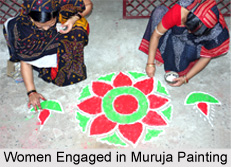 Muruja Painting is an art form popular in the Odisha state of India. It is an art form which represents the contemporary arts of India. It depicts the creativity and the varied forms of artistic expressions of Odisha. Its origin can be traced to several years back. Muruja is basically another format of Rangoli.
Muruja Painting is an art form popular in the Odisha state of India. It is an art form which represents the contemporary arts of India. It depicts the creativity and the varied forms of artistic expressions of Odisha. Its origin can be traced to several years back. Muruja is basically another format of Rangoli.
Steps of Muruja Painting
The drawing of the muruja designs needs a lot of skill and practice. Muruja is drawn on the floor with various powders of different hues. In order to get colour powders, indigenous methods are used. First the muruja is drawn on the floor with multi hued powders. While stones yield the white powder, the charred coconut shells yield the black powder. The marigold petals or turmeric are used in order to procure yellow paste. The dry leaves are crushed to give the green powder and the red hues are generated from bricks or the red clay. Some women make the muruja with just flowers. The powder is held between the tips of the thumb and the forefinger, and allowed to fall delicately through them to form lines and patterns.
Religious Significance of Muruja Painting
The muruja paintings are used in religious ceremonies where they are used in the form of mandalas. During the month of November, the elaborate muruja patterns are drawn near the holy tulsi plant. Muruja paintings are done on grain bins, on pavilions for household deities, on the doorstep of homes and on earthen pots which are used for occasions.
This article is a stub. You can enrich by adding more information to it. Send your Write Up to content@indianetzone.com



















